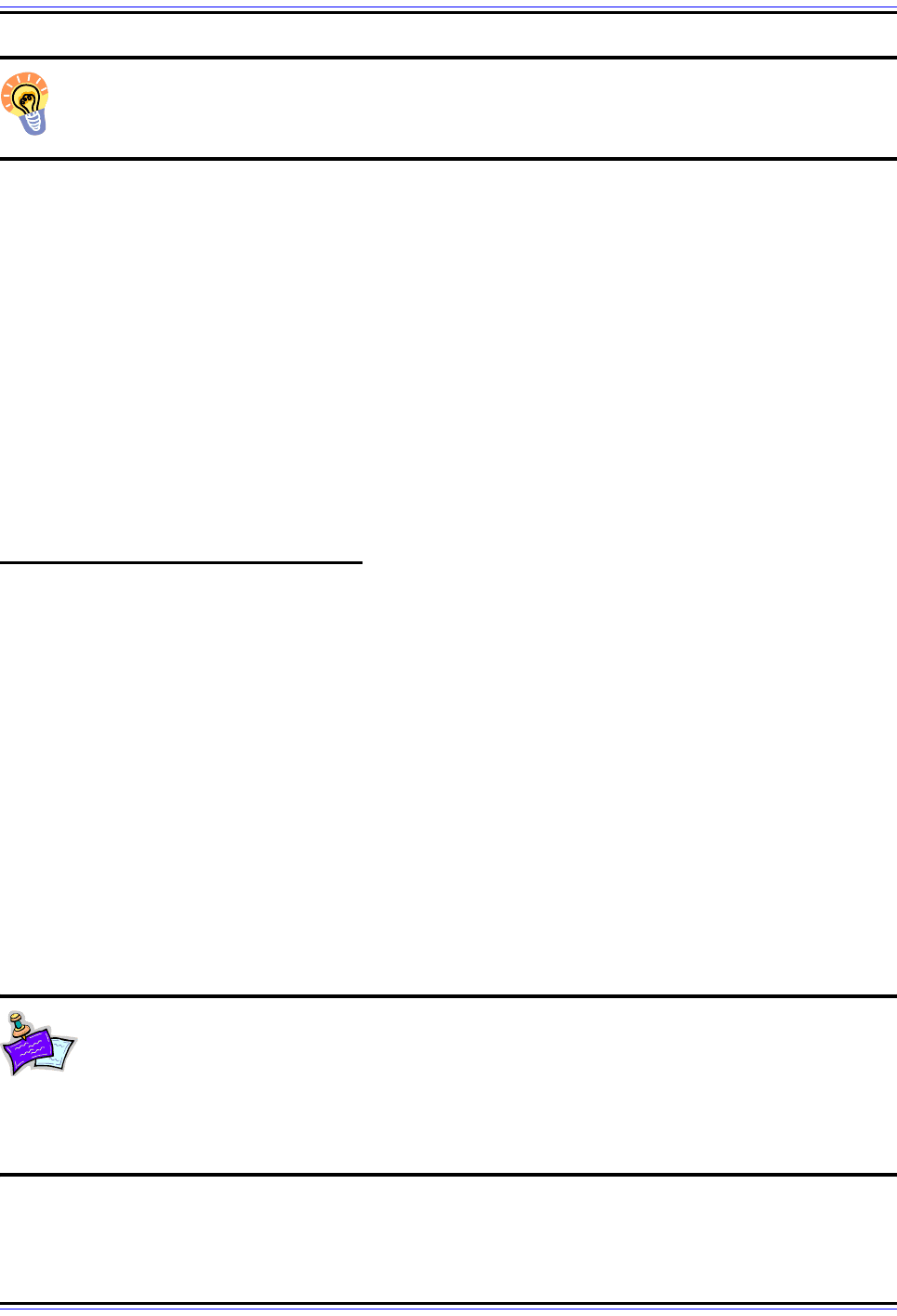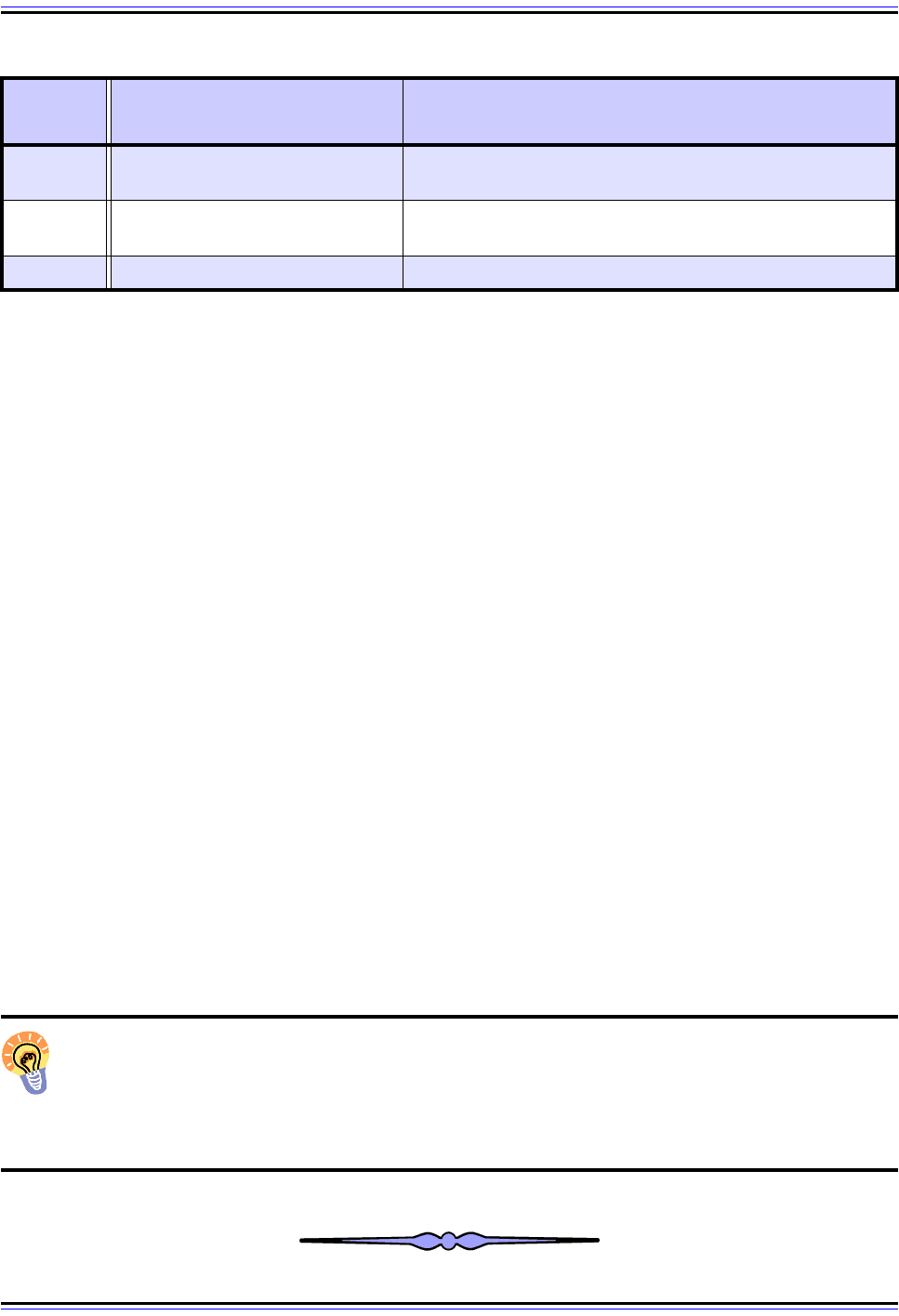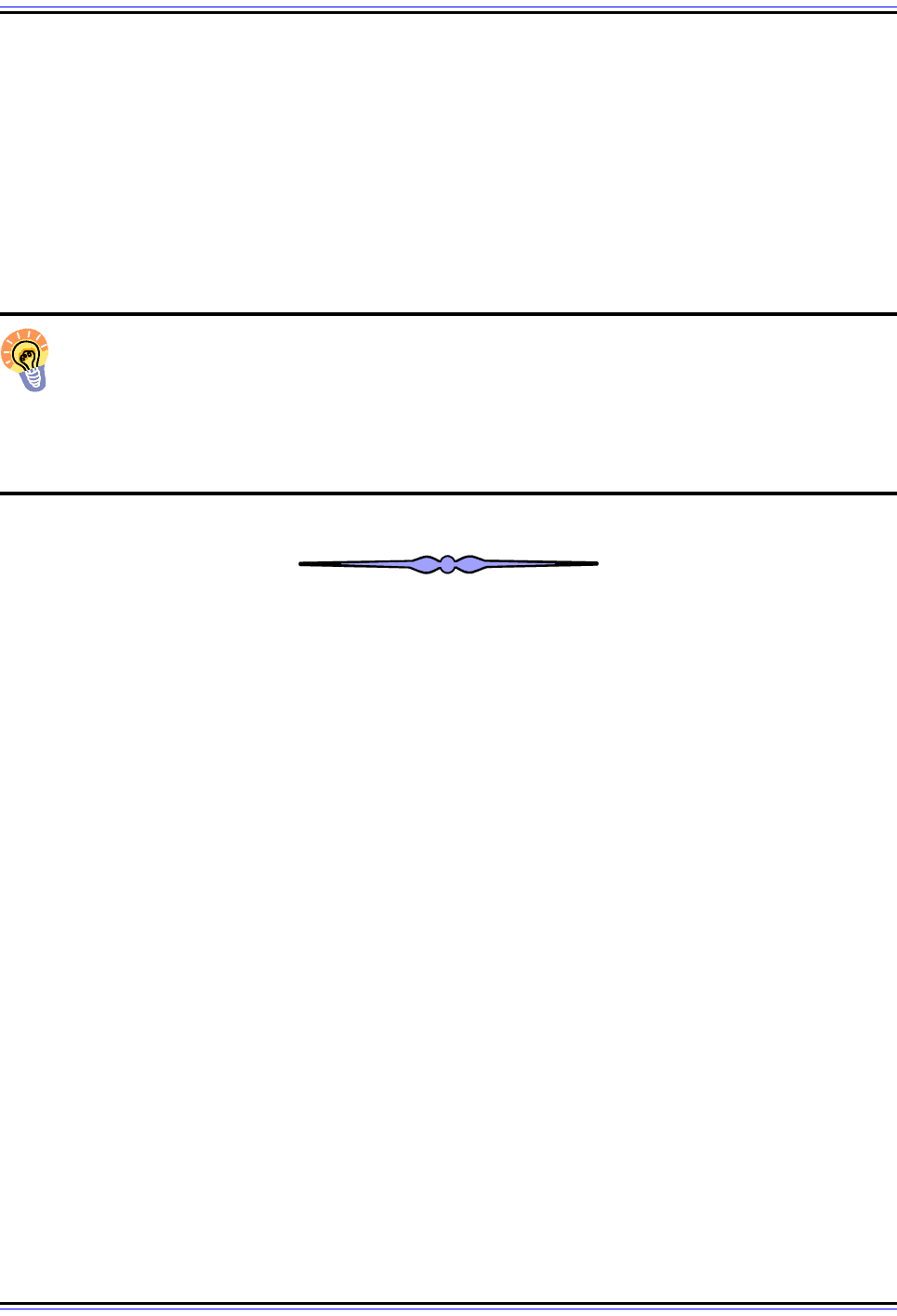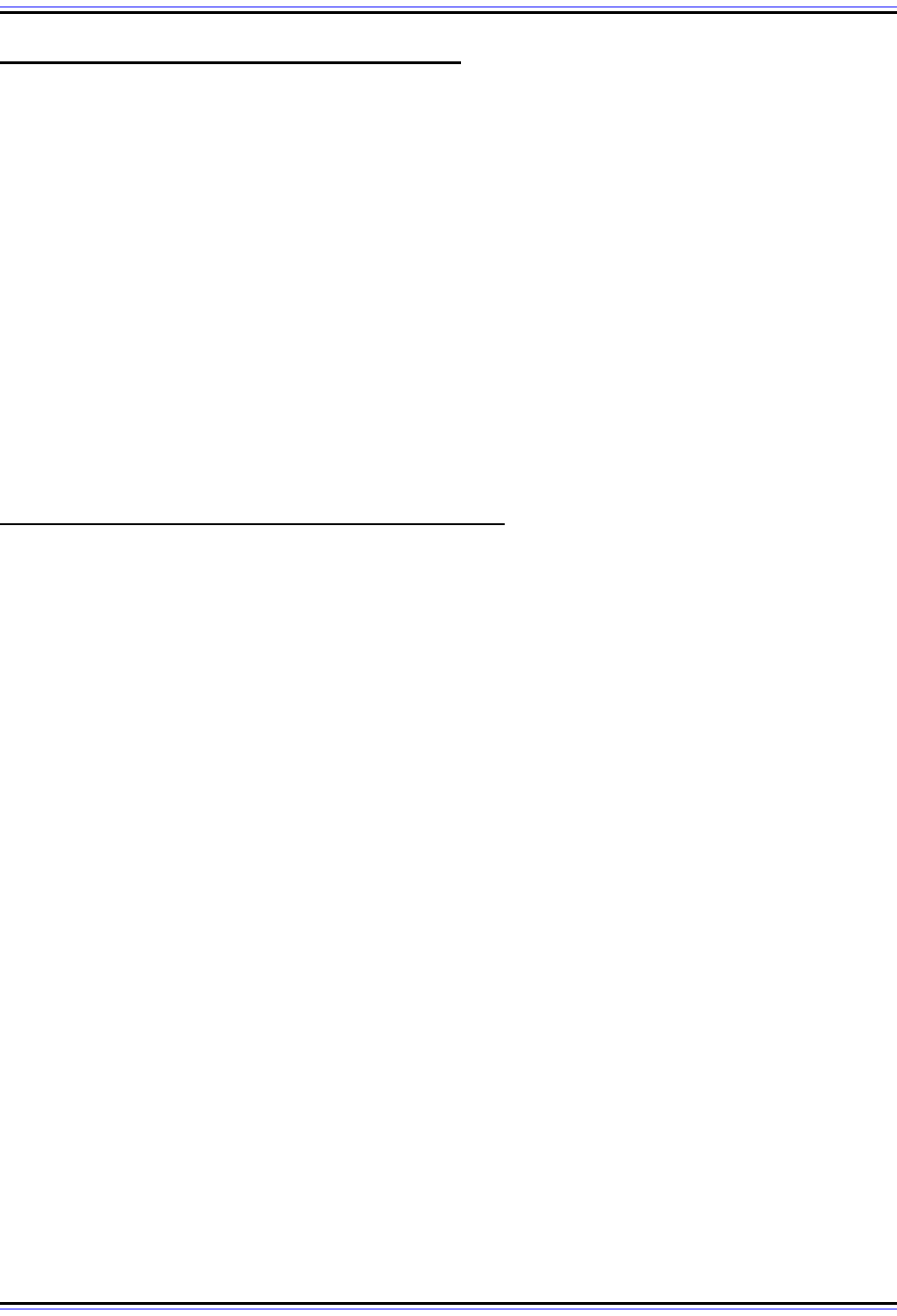Charles M. Kozierok The TCP-IP Guide
Подождите немного. Документ загружается.


The TCP/IP Guide - Version 3.0 (Contents) ` 1441 _ © 2001-2005 Charles M. Kozierok. All Rights Reserved.
Key Concept: The SMTP sender performs operations using a set of SMTP
commands. Each command is identifies using a four-letter code. Since SMTP only
supports a limited number of functions, it has a small command set.
Obsolete SMTP Commands
The commands in the preceding table are the ones that are most commonly used in SMTP
today. In addition to those, there are also certain commands that were originally defined in
RFC 821 but have since become obsolete. These include the following:
☯ SEND, SAML (“send and mail”) and SOML (“send or mail”): RFC 821 defined a
distinct mechanism for delivering mail directly to a user's terminal as opposed to a
mailbox, optionally in combination with conventional e-mail delivery. These were rarely
implemented and obsoleted in RFC 2821.
☯ TURN: Reverses the role of the SMTP sender and receiver as described in the SMTP
special features topic. This had a number of implementation and security issues and
was removed from the standard in RFC 2821.
SMTP Replies and Reply Codes
SMTP communication begins with the establishment of an SMTP session between an
SMTP sender (the device acting as a client) and an SMTP receiver (the device acting as a
server). All protocol operations then consist of plain ASCII text SMTP commands issued by
the sender to the receiver. The receiver analyzes each command, carries out the instruction
requested by the sender if possible, and then responds back with a reply to the sender. The
reply serves several functions: confirming command receipt; indicating if the command was
accepted or not; and communicating the result of processing the command.
Just as SMTP commands are sent in a manner reminiscent of how FTP internal commands
work, SMTP replies are formatted and interpreted in a way almost identical to that of FTP
replies. As with FTP, the reply consists not just of a string of reply text, but a combination of
reply text and a numerical reply code. And as with FTP, these reply codes use three digits to
encode various information about the reply, with each digit having a particular significance.
The reply code is really the key part of the reply, with the reply text being merely descriptive.
Note: The topic on FTP reply codes contains a thorough explanation of the
benefits of using these structure numeric reply codes. Since the SMTP system is
so similar, I won't duplicate that discussion in this topic. I will, however, fully
describe the syntax and semantics of SMTP reply codes here, in order both to keep this
section on SMTP self-contained, and to indicate where the differences are between FTP
and SMTP reply codes.

The TCP/IP Guide - Version 3.0 (Contents) ` 1442 _ © 2001-2005 Charles M. Kozierok. All Rights Reserved.
Reply Code Structure and Digit Interpretation
SMTP reply codes can be considered to be of the form “xyz”, where “x” is the first digit, “y”
the second and “z” the third. Here is how these digits are used.
First Reply Code Digit (“x”)
The leading reply code digit indicates the success or failure of the command in general
terms, whether a successful command is complete or incomplete, and whether an unsuc-
cessful one should be tried again or not. This particular digit is interpreted in exactly the
same way as it is in FTP, as shown in Table 254.
Table 254: SMTP Reply Code Format: First Digit Interpretation
Reply
Code
Format
Meaning Description
1yz
Positive
Preliminary Reply
An initial response indicating that the command has been accepted and
processing of it is still in progress. The SMTP sender should expect
another reply before a new command may be sent.
Note that while this first digit type is formally defined in the SMTP speci-
fication for completeness, it is not currently actually used by any of the
SMTP commands. That is to say, there are no reply codes between 100
and 199 in SMTP.
2yz
Positive
Completion Reply
The command has been successfully processed and completed.
3yz
Positive
Intermediate Reply
The command was accepted, but processing of it has been delayed,
pending receipt of additional information. One example of where this
type of reply is often made is after receipt of a DATA command, to
prompt the SMTP sender to then send the actual e-mail message to be
transferred.
4yz
Transient Negative
Completion Reply
The command was not accepted and no action was taken, but the error
is temporary and the command may be tried again. This is used for
errors that may be a result of temporary glitches or conditions that may
change, such as a resource on the SMTP server being temporarily
busy.
5yz
Permanent
Negative
Completion Reply
The command was not accepted and no action was taken. Trying the
same command again is likely to result in another error. An example
would be sending an invalid command.

The TCP/IP Guide - Version 3.0 (Contents) ` 1443 _ © 2001-2005 Charles M. Kozierok. All Rights Reserved.
Second Reply Code Digit (“y”)
The middle digit categorizes messages into functional groups. This digit is used in the same
general way as in FTP, but some of the functional groups are different in SMTP, as you can
see in Table 255.
Third Reply Code Digit (“z”)
The last digit indicates a specific type of message within each of the functional groups
described by the second digit. The third digit allows each functional group to have 10
different reply codes for each reply type given by the first code digit (preliminary success,
transient failure and so on.)
Combining Digit Values to Make Specific Reply Codes
Again, as in FTP, these “x”, “y” and “z” digit meanings are combined to make specific reply
codes. For example, the reply code “250” is a positive reply indicating command
completion, related to the mail system. It usually is used to indicate that a requested mail
command was completed successfully.
Common SMTP Reply Codes
Table 256 contains a list of some of the more common SMTP reply codes taken from RFC
2821, in numerical order. For each, I have shown the “typical” reply text specified in the
standard, and provided additional descriptive information where I felt it was needed.
Table 255: SMTP Reply Code Format: Second Digit Interpretation
Reply
Code
Format
Meaning Description
x0z Syntax Syntax errors or miscellaneous messages.
x1z Information Replies to requests for information, such as status requests.
x2z Connections
Replies related to the connection between the SMTP sender and SMTP
receiver.
x3z Unspecified Not defined.
x4z Unspecified Not defined.
x5z Mail System Replies related to the SMTP mail service itself.
Table 256: SMTP Reply Codes (Page 1 of 3)
Reply
Code
Reply Text Description
211
System status or system help
reply.
214 <Help message…> Used for text sent in reply to the HELP command.

The TCP/IP Guide - Version 3.0 (Contents) ` 1444 _ © 2001-2005 Charles M. Kozierok. All Rights Reserved.
220 <servername> Service ready.
Greeting message sent when TCP connection is first
established to an SMTP server.
221
<servername> closing trans-
mission channel.
Goodbye message sent in response to a QUIT message.
250
Requested mail action okay,
completed
Indicates successful execution of a variety of commands.
251
User not local; will forward to
<forward-path>
Used when the SMTP receiver agrees to forward a
message to a non-local user.
252
Cannot VRFY user, but will accept
message and attempt delivery
Indicates that a server tried to verify an e-mail address, but
was not able to do so completely. Usually means the
address appears to be valid but it was not possible to
positively ascertain this to be true.
354
Start mail input; end with
<CRLF>.<CRLF>
Intermediate reply to a DATA command.
421
<servername> Service not
available, closing transmission
channel
Sent in response to any command when the SMTP
receiver prematurely terminates the connection. A
common reason for this is receipt of a local shutdown
command, due for example to a hardware reboot.
450
Requested mail action not taken:
mailbox unavailable
Sent when a mailbox is busy due to another process
accessing it.
451
Requested action aborted: local
error in processing
Local processing problem on the server.
452
Requested action not taken:
insufficient system storage.
Time to clean out the server's hard disk! ☺
500
Syntax error, command
unrecognized
Response to a bad command or one that was too long.
501
Syntax error in parameters or
arguments
502 Command not implemented
Command is valid for SMTP in general but not supported
by this particular server.
503 Bad sequence of commands
Commands were not sent in the correct order, such as
sending the DATA command before the MAIL command.
504
Command parameter not
implemented.
550
Requested action not taken:
mailbox unavailable
Generic response given due to a problem with a specified
mailbox. This includes trying to send mail to an invalid
address, refusal to relay to a non-local mailbox and so
forth.
551
User not local; please try
<forward-path>
Tells the SMTP sender to try a different path; may be used
to support mailbox forwarding.
Table 256: SMTP Reply Codes (Page 2 of 3)
Reply
Code
Reply Text Description

The TCP/IP Guide - Version 3.0 (Contents) ` 1445 _ © 2001-2005 Charles M. Kozierok. All Rights Reserved.
As mentioned before, the actual text string for each reply code is implementation-specific.
While the standard specifies “dry” response text such as “Requested action completed” for
a 250 message, some servers customize this code, or even give different replies to different
250 messages depending on context. Again, there are examples of this in other topics.
SMTP Multiple-Line Text Replies
Again, as in FTP, it is possible for a reply to contain more than one line of text. In this case,
each line starts with the reply code, and all lines but the last have a hyphen between the
reply code and the reply text, to indicate that the reply continues. The last line has a space
between the reply code and text, just like a single-line reply. An example of this was given in
the topic on SMTP connections where I showed a multi-line response to a EHLO command.
Enhanced Status Code Replies
When the ENHANCEDSTATUSCODES SMTP extension is enabled, this causes supple-
mental reply codes to be issued by the SMTP receiver in response to each command.
These codes are similar in some respects to the standard reply codes; they also use three
digits, but the digits are separated by periods. These enhanced codes provide more infor-
mation about the results of operations, especially errors.
For example, if you try to issue a RCPT command specifying a non-local mailbox on a
server not supporting this feature, it will send back a “550” reply, which is a generic error
(“requested action not taken: mailbox unavailable”). When enhanced status codes are
active, the response will be “550 5.7.1”, the more specific message “delivery not authorized,
request refused”. A full description of these enhanced codes can be found in RFC 1893.
Key Concept: Each time the SMTP sender issues a command, it receives a reply
from the SMTP receiver. SMTP replies are similar to FTP replies, using both a three-
digit reply code and a descriptive text line. A special enhanced status codes SMTP
extension is also defined; when enabled, this causes the SMTP receiver to return more
detailed result information after processing a command.
552
Requested mail action aborted:
exceeded storage allocation
User's mailbox is full.
553
Requested action not taken:
mailbox name not allowed
Specification of an invalid mailbox address.
554 Transaction failed. General failure of a transaction.
Table 256: SMTP Reply Codes (Page 3 of 3)
Reply
Code
Reply Text Description

The TCP/IP Guide - Version 3.0 (Contents) ` 1446 _ © 2001-2005 Charles M. Kozierok. All Rights Reserved.
TCP/IP Electronic Mail Access and Retrieval Protocols and Methods
The Simple Mail Transfer Protocol (SMTP) is responsible for most of the process of sending
an e-mail message from the originator to the recipient. SMTP's job ends when the message
has been successfully deposited into the recipient's mailbox on his or her local SMTP
server.
In some cases this mailbox is the end of the message's travels through cyberspace. More
often, however, it is only a “rest stop”—the last step of the journey is for the message to be
actually accessed and read by the user to whom it was sent. This may require that it be
retrieved from the mailbox and transferred to another client machine. For a variety of
reasons, SMTP is not used for the process of accessing a mailbox, but rather a special set
of protocols and methods designed specifically for electronic mail access and retrieval.
In this section, I describe some of the more common techniques used for TCP/IP e-mail
access and retrieval. I begin with an overview of the subject that describes in general the
different paradigms used for e-mail access and gives an overview of the protocols. I then
have subsections that cover the two mail TCP/IP e-mail access and retrieval protocols: the
Post Office Protocol (POP) and the Internet Message Access Protocol (IMAP). I also have a
third, smaller subsection that discusses other methods of e-mail access.
Note that this section assumes that you already have familiarity with SMTP and the
operation of the TCP/IP e-mail system as a whole.

The TCP/IP Guide - Version 3.0 (Contents) ` 1447 _ © 2001-2005 Charles M. Kozierok. All Rights Reserved.
TCP/IP Electronic Mail Mailbox Access Model, Method and Protocol Overview
In an ideal world… we would all be born knowing everything there is to know about
computers and networking, and I'd have become a famous novelist instead of writing
thousands of pages of this stuff. ☺ Well, that may be asking a bit too much, but wouldn't it
have been nice if every device on the Internet simply ran SMTP server software? If so, then
that one protocol would be sufficient to implement the entire TCP/IP e-mail system. You
would just compose e-mail on your machine, and your SMTP software would send it to your
recipient's, and he or she would read it. Nice and simple.
Back here in the real world, however, this is really not possible in general terms. As I
explained in the overview section on e-mail and the discussion of SMTP, an SMTP server
must be connected to the Internet and available around the clock to receive e-mail sent at
any time by any of the millions of other computers in the world. Most of us either cannot or
do not want to run machines continuously connected to the Internet, nor do we want to
configure and maintain potentially-complex SMTP software. This is the reason why a
complete e-mail exchange normally involves not two devices but four: a message is
composed on the sender's client machine, transferred to the sender's SMTP server, then to
the recipient's SMTP server, and finally, to the recipient's machine.
The Advantages of Specialized Mail Access and Retrieval Protocols
The communication between SMTP servers is of course done with SMTP. So is the initial
step of sending the e-mail from the sender's machine to the sender's SMTP server.
However, SMTP is not used for the last part of the process, accessing the recipient's
mailbox. Instead, a set of mailbox access and retrieval protocols and methods were
devised.
A fair question is… why was this done? Why not simply have mail sit “pending” on the
recipient's SMTP server and then have it send the mail to the recipient client device when it
comes online, using SMTP? There are two main reasons for this. The first is that SMTP
was designed for the specific purpose of transporting e-mail only. Having it responsible for
client mailbox access would require adding more functionality, making it difficult to keep
SMTP “simple”. Also, SMTP works on a “push” model, with transactions being initiated by
the sender. It would need changes to allow it to respond to requests from a client device
that is only online intermittently.
But the second reason is probably more important: flexibility in how electronic mail is
accessed. If we used SMTP, all we would be able to do is transfer e-mail to the recipient's
client machine. This would be functional, but would greatly limit the capabilities of how e-
mail is used. For example, some users might wish to access mail directly on the server and
manipulate it there. Also consider the problem of people with special requirements, such as
those who travel and may need to access e-mail from a number of different client devices.

The TCP/IP Guide - Version 3.0 (Contents) ` 1448 _ © 2001-2005 Charles M. Kozierok. All Rights Reserved.
E-Mail Access and Retrieval Models
For the reasons just examined, there is an advantage to providing more than one way to
access a mailbox. RFC 1733, Distributed Electronic Mail Models In IMAP4, describes three
different paradigms or models for mail access and retrieval:
☯ Online Access Model: This is the mode of access that we would all be using in my
“ideal world” scenario, where every machine was always connected to the Internet
running an SMTP server. You would have constant, direct online access to your
mailbox. In the real world, this model is still used by some Internet users, especially
those who have UNIX accounts or run their own SMTP servers. I call this direct server
access.
☯ Offline Access Model: In this paradigm, a user establishes a connection to a server
where his or her mailbox is located. The user downloads received messages to the
client device, and then deletes them from the server mailbox. All reading and other
activity performed on the mail can be done “offline” once the mail has been retrieved.
☯ Disconnected Access Model: This is a hybrid of online and offline access. The user
downloads messages from the server, so he or she can read or otherwise manipulate
them without requiring a continuous connection to the server. However, the mail is not
deleted from the server, like in the offline model. At some time in the future, the user
connects back with the server and synchronizes any changes made on the local
device with the mailbox on the server.
What sort of changes? Examples include marking whether or not a message has been
read, to keep track of unread mail, and marking messages to which the user has
already replied. These are important tools to help those with busy mailboxes keep
track of what they need to do.
Comparing E-Mail Access and Retrieval Models
Of the three, which is best? You should know better than to ask me that question. ☺ Each
has advantages and disadvantages, which is why it is good that we have these options
rather than the single SMTP protocol for mail access.
Direct server access has the main benefits of instant speed and universal access from any
location. It has the disadvantage that you must be online to read mail, and that it usually
requires you to use UNIX e-mail clients that most people are not familiar with. However, the
Internet Message Access Protocol (IMAP) can also be used for online access.
Offline access has the main advantages of simplicity and short connection time require-
ments; you can easily connect to the mailbox, download messages and then read them
locally. But that makes this method somewhat inflexible, and poorly-suited to access from
different machines. Still, it is right now the most popular access method, because simplicity
is important; it is best typified by the popular Post Office Protocol (POP).
Disconnected access attempts to combine the advantages of offline and online access
without combining their disadvantages, and does a pretty good job. The advantages are
significant: the ability to quickly access mail and use it offline, while retaining and updating
the mailbox on the server to allow access from different client machines. IMAP is the

The TCP/IP Guide - Version 3.0 (Contents) ` 1449 _ © 2001-2005 Charles M. Kozierok. All Rights Reserved.
protocol popularly used for disconnected access. In the IMAP overview I explore its advan-
tages over offline access, as well as its main disadvantages: complexity and far less
universal support than POP (though acceptance of IMAP is slowly increasing).
Finally, in recent years, a somewhat new mailbox access method has become popular: e-
mail access using the World Wide Web. This technique allows a user to access his or her
mailbox from any computer with an Internet connection and a Web browser. It is a good
example of “line blurring”, not only between the access models discussed here, but
between TCP/IP applications, in this case the Web and e-mail.
Key Concept: For flexibility, TCP/IP uses a variety of mailbox access and retrieval
protocols and methods to allow users to read e-mail. Three different models describe
how these different methods work: the online model, in which e-mail is accessed and
read on the server; the offline model, in which mail is transferred to the client device and
used there; and the disconnected model, where mail is retrieved and read offline but
remains on the server with changes synchronized for consistency.

The TCP/IP Guide - Version 3.0 (Contents) ` 1450 _ © 2001-2005 Charles M. Kozierok. All Rights Reserved.
TCP/IP Post Office Protocol (POP/POP3)
The overall communication model used for TCP/IP e-mail gives many options to an e-mail
user for accessing his or her electronic mailbox. The most popular access method today is
the simple offline access model, where a client device accesses a server, retrieves mail and
deletes it from the server. The Post Office Protocol (POP) was designed for quick, simple
and efficient mail access; it is used by millions of people to access billions of e-mail
messages every day.
In this section I describe the operation of the Post Office Protocol, focusing on version 3
(POP3). I begin by looking at the protocol in general terms, discussing its history, the
various versions of the protocol and the standards that define them. I describe POP3's
general operation and the communication between a client and server, concentrating on the
three main states through which the session transitions. I then describe each of these
states in sequence: the Authorization state, Transaction state and Update state. For each, I
explain the communication processes that take place and the commands and replies that
implement them.
POP Overview, History, Versions and Standards
Of the three mailbox access paradigms, online, offline and disconnected, the offline model
is probably the least capable in terms of features. And it is also the most popular! This may
seem counter-intuitive, but it is in fact a pattern that repeats itself over and over in the
worlds of computing and networking: a good example would be Ethernet beating Token
Ring in the LAN market. The reason is that simplicity and ease of implementation are keys
to the success of any technology, and the offline mail access model beats the other two in
these areas.
The history of offline e-mail access goes back farther than one might expect—to the early
1980s. Two decades ago, we didn't have nearly everyone and his brother accessing the
Internet to check e-mail the way we do today. In fact, there were only a relatively small
number of machines connected using TCP/IP, and most users of these machines had the
ability to access their e-mail on-server, using the online access model.
However, even back then, developers recognized the advantages of being able to retrieve
e-mail from a server directly to a client computer, rather than accessing the mailbox on the
server using Teln et or NFS. In 1984, RFC 918 was published, defining the Post Office
Protocol (POP). The idea behind POP was to provide a simple way for a client computer to
retrieve e-mail from a mailbox on an SMTP server so it could used locally.
The emphasis was on simple; the RFC for this first version of POP is only 5 pages long,
and the standard it defined is extremely rudimentary. It describes only a simple sequence of
operations where a user gives a name and password for authentication, and then
downloads the entire contents of a mailbox. Simple is good, but there are limits.
